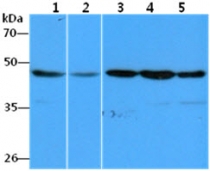ARG57041
anti-eEF1A1 antibody [23C11]
anti-eEF1A1 antibody [23C11] for Western blot and Human
Overview
| Product Description | Mouse Monoclonal antibody [23C11] recognizes eEF1A1 |
|---|---|
| Tested Reactivity | Hu |
| Tested Application | WB |
| Host | Mouse |
| Clonality | Monoclonal |
| Clone | 23C11 |
| Isotype | IgG2a, kappa |
| Target Name | eEF1A1 |
| Antigen Species | Human |
| Immunogen | Recombinant fragment around aa. 1-462 of Human eEF1A1. |
| Conjugation | Un-conjugated |
| Alternate Names | EE1A1; EEF-1; Eukaryotic elongation factor 1 A-1; CCS-3; GRAF-1EF; LENG7; EEF1A; CCS3; HNGC:16303; EF-Tu; Elongation factor Tu; Leukocyte receptor cluster member 7; eEF1A-1; PTI1; EF1A; EF-1-alpha-1; Elongation factor 1-alpha 1 |
Application Instructions
| Application Suggestion |
|
||||
|---|---|---|---|---|---|
| Application Note | * The dilutions indicate recommended starting dilutions and the optimal dilutions or concentrations should be determined by the scientist. |
Properties
| Form | Liquid |
|---|---|
| Purification | Purification with Protein A. |
| Buffer | PBS (pH 7.4), 0.02% Sodium azide and 10% Glycerol. |
| Preservative | 0.02% Sodium azide |
| Stabilizer | 10% Glycerol |
| Concentration | 1 mg/ml |
| Storage Instruction | For continuous use, store undiluted antibody at 2-8°C for up to a week. For long-term storage, aliquot and store at -20°C. Storage in frost free freezers is not recommended. Avoid repeated freeze/thaw cycles. Suggest spin the vial prior to opening. The antibody solution should be gently mixed before use. |
| Note | For laboratory research only, not for drug, diagnostic or other use. |
Bioinformation
| Database Links | |
|---|---|
| Gene Symbol | EEF1A1 |
| Gene Full Name | eukaryotic translation elongation factor 1 alpha 1 |
| Background | This gene encodes an isoform of the alpha subunit of the elongation factor-1 complex, which is responsible for the enzymatic delivery of aminoacyl tRNAs to the ribosome. This isoform (alpha 1) is expressed in brain, placenta, lung, liver, kidney, and pancreas, and the other isoform (alpha 2) is expressed in brain, heart and skeletal muscle. This isoform is identified as an autoantigen in 66% of patients with Felty syndrome. This gene has been found to have multiple copies on many chromosomes, some of which, if not all, represent different pseudogenes. [provided by RefSeq, Jul 2008] |
| Function | This protein promotes the GTP-dependent binding of aminoacyl-tRNA to the A-site of ribosomes during protein biosynthesis. With PARP1 and TXK, forms a complex that acts as a T helper 1 (Th1) cell-specific transcription factor and binds the promoter of IFN-gamma to directly regulate its transcription, and is thus involved importantly in Th1 cytokine production. [UniProt] |
| Calculated MW | 50 kDa |
| PTM | ISGylated. Phosphorylated by TXK. Phosphorylation by PASK increases translation efficiency. Phosphorylated by ROCK2 (PubMed:26497934). Trimethylated at Lys-79 by EEF1AKMT1 (PubMed:26545399). Methylated at Lys-165 by EEF1AKMT3, methylation by EEF1AKMT3 is dynamic as well as inducible by stress conditions, such as ER-stress, and plays a regulatory role on mRNA translation (PubMed:28108655). Trimethylated at Lys-318 by EEF1AKMT2 (PubMed:25144183). |
Images (1) Click the Picture to Zoom In






